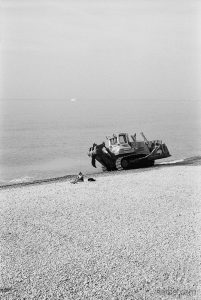Perhaps I should have called this Another Kind of Portrait. I get great joy from making informal, somewhat secret photographs of people. Capturing individuals in a particular setting. I try hard to stay anonymous. Unseen. I want to achieve a natural representation of a single person in their particular moment. These are Photographs that I imagine the subject might appreciate, or at least be able to contextualize. Me, I make up little stories or vignettes for myself when I look at these photographs.

Harbel: The Cadet
I think of my portraits as small stories that I hope in some cases will remain relevant well beyond the present. I have no responsibility to anyone to make a great likeness, nor do I have to explain or seek the appreciation of the subject, who is unlikely to ever see their photograph.
Portraits have always had a certain formality about them. A sculptor, painter, or early photographer would have a person sit for a long, long time before delivering a likeness of the sitter. In photography terms, it used to be a matter of going to a photographer’s studio and sitting still before a backdrop and waiting for the negative to be developed and a print made in the darkroom. Then with faster film, the camera came off the tripod and more dynamic photographs became possible.
My photographs are more than anything a response to one of the more shattering moments in my art history education: The 1962 Diane Arbus’ photograph of the young man with the hand grenade in Central Park. Arbus took an entire roll of medium format photographs. 12 photographs. On the contact sheet, 11 of the 12 images show a regular looking kid playing in the park, like any other kid. But there is one of the 12 photographs, where the boy is making an ugly face and his body appears strangely rigid. The boy looks like he is possessed and perhaps a person with some severe mental challenges. By looking at the contact sheet, we know this is not true, but this is the photograph that Diane Arbus chose.
I reacted badly to this revelation. Diane Arbus was one of the reasons I started making photographs in the first place. As such, I now take extra care to try to be honest and fair. When a photographer makes photographs of someone not aware that they are being photographed, there needs to be accountability and fairness. The photographer cannot be greedy, ungrateful or take unreasonable advantage
The photographs in this group – The Ones Gallery on Harbel.com – are my way of seeing. I hope the viewer might appreciate what I saw, but in such a way that the context is still a bit of a mystery. There are only minimal titles and no locations indicated. In my mind, a photograph should leave the viewer to make their own story. Their vignette, which might very well be different than mine. I like this. All my photographs are analog. I am a follower of the great Italian photographer Gianni Berengo Gardin and have picked up his use of the green stamp that reads: Vera Fotografia – Italian for real photograph – on all my prints. Vera Fotografia confirms that this is a photograph made from an analog negative and printed by hand in a conventional darkroom. There is no digital manipulation or intervention what-so-ever.

Harbel: First rays
My photographs may not be classic portraits, but to me, a single figure – often unaware – in a particular setting is my kind of portrait.
Harbel,
Donostia

